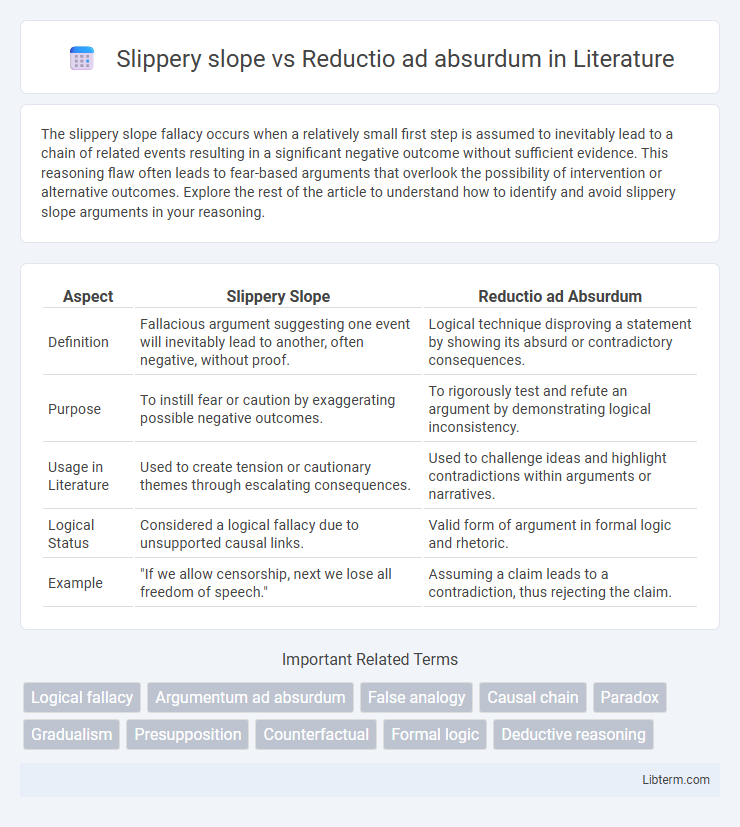The slippery slope fallacy occurs when a relatively small first step is assumed to inevitably lead to a chain of related events resulting in a significant negative outcome without sufficient evidence. This reasoning flaw often leads to fear-based arguments that overlook the possibility of intervention or alternative outcomes. Explore the rest of the article to understand how to identify and avoid slippery slope arguments in your reasoning.
Table of Comparison
| Aspect | Slippery Slope | Reductio ad Absurdum |
|---|---|---|
| Definition | Fallacious argument suggesting one event will inevitably lead to another, often negative, without proof. | Logical technique disproving a statement by showing its absurd or contradictory consequences. |
| Purpose | To instill fear or caution by exaggerating possible negative outcomes. | To rigorously test and refute an argument by demonstrating logical inconsistency. |
| Usage in Literature | Used to create tension or cautionary themes through escalating consequences. | Used to challenge ideas and highlight contradictions within arguments or narratives. |
| Logical Status | Considered a logical fallacy due to unsupported causal links. | Valid form of argument in formal logic and rhetoric. |
| Example | "If we allow censorship, next we lose all freedom of speech." | Assuming a claim leads to a contradiction, thus rejecting the claim. |
Understanding Slippery Slope Fallacy
The slippery slope fallacy occurs when it is incorrectly assumed that a relatively small first step will inevitably lead to a chain of related negative events without sufficient evidence. This reasoning exaggerates consequences, ignoring the possibility of intervening factors or alternative outcomes, thereby distorting logical analysis. In contrast, reductio ad absurdum uses logical deduction to show that a premise leads to an absurd or contradictory conclusion, effectively disproving the initial claim.
What is Reductio ad Absurdum?
Reductio ad absurdum is a logical argument technique that disproves a statement by demonstrating that its logical conclusion leads to an absurd or contradictory result. Unlike the slippery slope fallacy, which incorrectly assumes a chain of events will inevitably occur, reductio ad absurdum rigorously tests the validity of a premise by highlighting inconsistencies. This method strengthens critical thinking by exposing flaws in reasoning through systematic contradiction.
Key Differences at a Glance
Slippery slope argues that one action will inevitably lead to a chain of related negative events, emphasizing a causal progression without sufficient evidence. Reductio ad absurdum disproves a proposition by showing that it logically leads to an absurd or contradictory conclusion, relying on formal logical contradiction. The key difference lies in slippery slope's speculative causal assertion versus reductio ad absurdum's formal logical refutation.
Common Examples of Slippery Slope
Common examples of slippery slope arguments include claims that legalizing recreational marijuana will inevitably lead to unrestricted drug use or that allowing same-sex marriage will result in the acceptance of polygamy or bestiality. These examples illustrate how slippery slope fallacies exaggerate consequences without sufficient evidence, contrasting with reductio ad absurdum, which seeks to demonstrate a statement's falsehood by highlighting logically absurd outcomes. Understanding these distinctions helps identify flawed reasoning often employed in political and social debates.
Typical Uses of Reductio ad Absurdum
Reductio ad absurdum is typically used to refute a proposition by demonstrating that its logical extension leads to absurd or contradictory conclusions, effectively undermining the original argument. It is commonly employed in mathematics, philosophy, and formal logic to test the validity of statements by assuming the opposite and revealing inconsistencies. This method contrasts with slippery slope arguments, which predict a chain reaction of negative events without necessarily providing a strict logical contradiction.
Identifying Logical Fallacies in Arguments
Slippery slope fallacy occurs when an argument asserts that a relatively small first step inevitably leads to a chain of related events culminating in a negative outcome, without evidence supporting this progression. Reductio ad absurdum involves disproving a statement by showing that its logical conclusion is absurd or contradictory, effectively using contradiction to validate or invalidate an argument. Identifying these logical fallacies requires analyzing the validity of causal links in slippery slope and examining the soundness of implications in reductio ad absurdum to ensure arguments are logically coherent and evidence-based.
Why Slippery Slope is Often Misused
Slippery slope arguments are often misused because they rely on unfounded causal chains that exaggerate potential consequences without sufficient evidence. Logical fallacies arise when speculative links between events lack empirical support, leading to misleading conclusions. In contrast, reductio ad absurdum employs valid deductive reasoning by demonstrating contradictions to refute a claim, making it a more rigorous argumentative method.
Strengthening Reasoning with Reductio ad Absurdum
Reductio ad absurdum strengthens reasoning by exposing contradictions through logical consequences, thereby proving a statement true by demonstrating that its negation leads to absurd or impossible scenarios. Unlike slippery slope arguments, which speculate unwarranted chain reactions, reductio ad absurdum relies on firm logical steps to invalidate opposing claims. This method enhances critical thinking by systematically breaking down arguments and reinforcing conclusions with rigorous proof.
Practical Implications in Debates and Discussions
Slippery slope arguments often hinder debates by invoking fear of extreme consequences without sufficient evidence, leading to emotional rather than rational decision-making. Reductio ad absurdum, when used effectively, exposes logical contradictions by demonstrating that a premise leads to an absurd or impossible conclusion, thereby strengthening critical analysis. Practitioners should distinguish between these techniques to avoid fallacious reasoning and promote sound argumentation in discussions.
Avoiding Confusion: Best Practices in Argumentation
Avoiding confusion between slippery slope and reductio ad absurdum involves clearly distinguishing their logical structures: slippery slope predicts a chain of negative events without sufficient evidence, while reductio ad absurdum demonstrates a statement's falsehood by showing its absurd consequences. Effective argumentation requires presenting concrete evidence for causal links in slippery slope claims to prevent fallacious reasoning. Clarifying the purpose and method of each argument type improves critical thinking and fosters clearer, more rational debates.
Slippery slope Infographic

 libterm.com
libterm.com